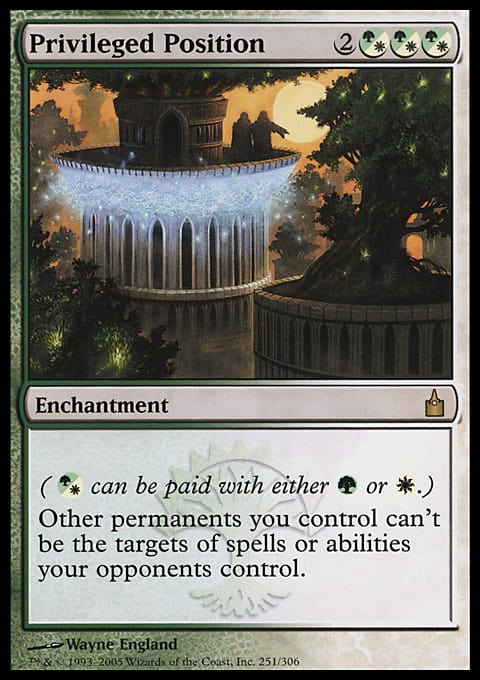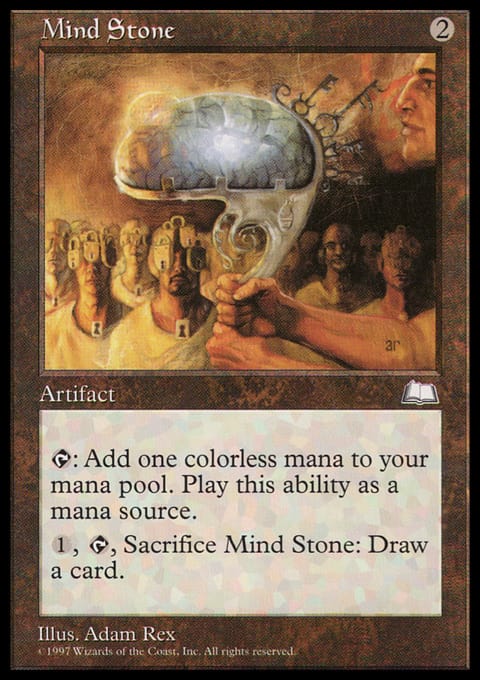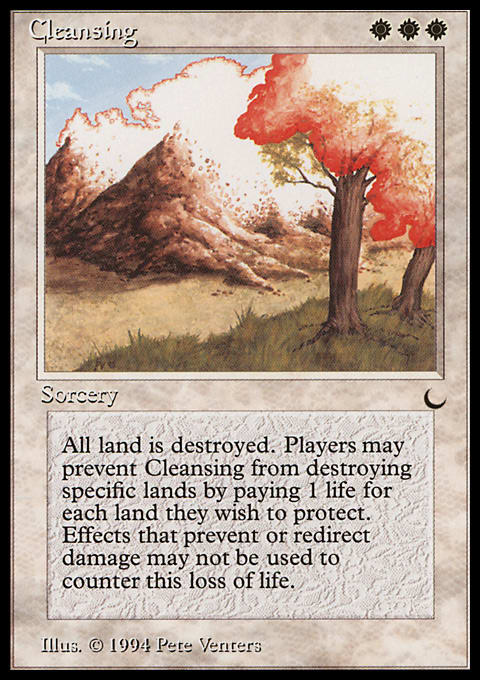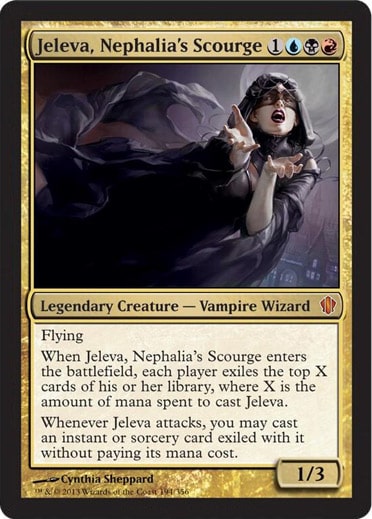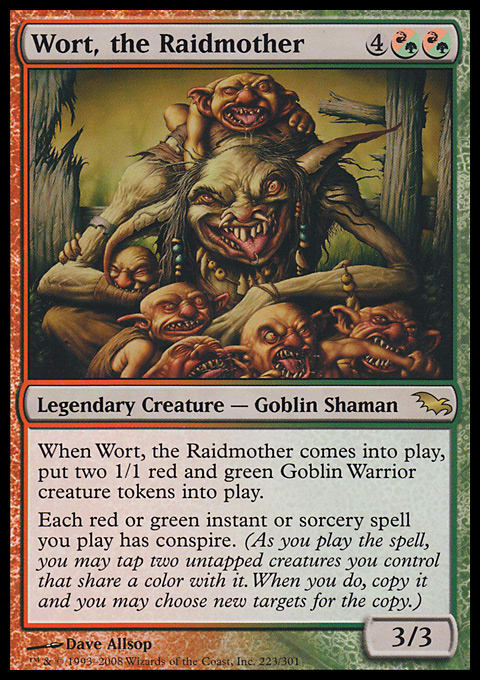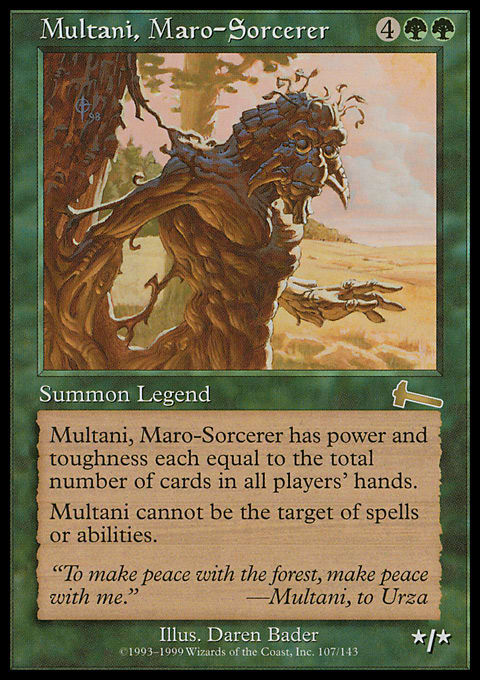Now, there's nothing wrong with those plays or decks, and those Canadians were great to play against. But we clearly had pretty different ideas about what constitutes a "casual" Commander deck. Recent debate over the Commander banned list, the "social contract," problem cards that aren't banned but are shunned in a lot of playgroups, and other issues brought this issue to mind again. Commander decks can be built with a wide range of power levels, and even if you follow the 75 percent rule, not everyone agrees on what that means or what a deck that follows it looks like. When you put players with different power level decks in the same game it can be a pretty bad experience.
Then I had an idea. What if we all self-evaluated our Commander decks and gave them a score? Then we could approach a game of Commander with strangers, or even in our own play groups, and say, "Hey, let's play a level 3 game, and if we have time we'll get one in with our level 4 decks later."
I present to you the Command Score.
- A level 1 deck is not focused on winning. It might be a deck that emphasizes the social aspect of the game, is built around an artist or an odd theme, or simply wants to create weird board states. It might also be a deck built by a newer player with less experience, or a small collection/budget.
- A level 2 deck functions decently, but is not especially powerful. It may be more focused on theme than power level, or it may intentionally use suboptimal cards to keep the power level down. These decks often lack synergy. It might be a level 3 deck that's still a work-in-progress.
- A level 3 deck is a solid deck with good cards and strong synergy. It has a consistent win condition, generates good card advantage, or can play early threats. While strong, these decks have vulnerabilities, take time to develop, and usually kill opponents one at a time.
- A level 4 deck is very strong. It's not afraid to use the best cards available to do what it wants to do. Tutors, mass land destruction, and problem cards like Exsanguinate and Deadeye Navigator find a home in level 4 decks. These decks can generate a consistent stream of hard-to-deal-with threats, or take very long turns in which they draw tons of cards and cast lots of spells. These decks are capable of killing all opponents at the table at once.
- Level 5 decks are the most brutal, no-holds-barred, cutthroat decks in Commander. They use early combos to win, or can create completely oppressive game states that prevent opponents from doing anything. These decks are most often found in competitive 1v1 Commander.
This is a not a perfect system, of course. Categorizing a deck is very subjective, and sometimes a deck can under or overperform its level. A level 2 that has a great opening hand can feel like a 3, and a 4 that misses a bunch of land drops feels . . . well, awful. It can also be hard to pick a single level when you're evaluating a deck — with my own decks, I often find I define them as a 2/3 or a 3/4. And that's fine, since a Commander game doesn't need to rigidly conform to a single level. A mix of 2s and 3s or 3s and 4s at the table will work fine, with the higher-level decks knowing going in that they'll have targets on their backs. But if you've got 2s and 4s in the same game, there's a higher chance that someone's going to have a bad time, and that's what we're trying to avoid.
If you keep this system in mind when building or modifying your decks, you can aim for a certain level. If you replace your Sol Ring with Mind Stone and take out the tutors for some basic card draw spells, you've done a good job of moving from 4 to 3, or maybe 3 to 2. You could also "pre-sideboard," in case you want to shift a deck's level to fit better in a given game. Let's say you're running Armageddon and Ravages of War, plus Deadeye Navigator in a deck. That is undoubtedly level 4. If the group you're playing with is in the 2 or 3 range, you can swap out those problem cards for something weaker that you keep in your deckbox. Maybe Ghostly Flicker goes in instead of Deadeye. Maybe Cleansing is better than Armageddon (or maybe you just avoid mass land destruction altogether and go with Oblivion Ring or some other good utility cards). This is also a great opportunity to grab a legend that's in the 99 and promote it to general, assuming it's got the right color identity. A slightly weaker commander that reduces a deck's consistency is a simple way to shift the level down.
Be aware that some decks that fit into level 1 can be frustrating or unpredictable to play against. A pillow fort deck that gains a ton of life and has no win condition might not be powerful, strictly speaking, but it can drag out already long games. Decks with a lot of "wacky" cards that do unusual things can also be difficult to deal with despite not having a lot of overt power.
Level 5 is a special case. I don't think it should mix with other levels, and there's a much clearer divide between 4 and 5 than between the other levels. If you have a level 5 deck, you know it, and you know who you can play against with it. If you have a group that you know enjoys this style of play, then great. But save the level 5 decks for that group alone, not the casual pick-up games.
Now, let's talk briefly about what the Command Score system does not do. It does not account for monetary cost. It is entirely possible to build a budget level 4 deck. A level 2 deck that is foiled out and uses only Summer Magic basic lands is still a level 2 deck. The system also does not account for how a deck is played. If your deck is full of land destruction spells, but you are careful to only use them against creature lands or pesky lands like Maze of Ith or Kor Haven, then you can honestly say the deck is a level 2 or 3. If you decide to destroy lands more ruthlessly, the deck can bump up a level with no changes in the decklist. This is, frankly, a gray area. Command Score also does not account for the metagame and for hate cards. A very efficient Golgari reanimator deck is easily a 4, but if everyone at the table is running graveyard hate, reanimator is going to be a flop.
One last point about the Command Score before we get to decklists: Commander decks are complicated beasts. I have definitely built decks that I was sure were 2s only to play a few games and realize the deck is really a 4. Synergies can turn out more powerful than expected, or combos you didn't plan on can massively power-up a deck. Be aware of this and reevaluate your decks in light of actual performance at the table.
If the idea of the Command Score still seems a little fuzzy, let's take a look at some sample decks. I'm not going to bother with a decklist for level 1, as people rarely build decks at this level on purpose, and even the Pre-constructed Commander decks are better than level 1 (they're mostly 2s and 3s). I'm also not going to give you a level 5 decklist, partly because I don't build those types of decks and partly because, if you're a person who likes level 5 Commander decks, you don't need me telling you how to build them.
So we'll start with level 2. As a reminder:
I've got the perfect example, my Jeleva, Nephalia's Scourge Gothic Horror Deck.
Jeleva, Nephalia?s Scourge Gothic Horror ? Commander | Ed Grabianowski
- Commander (1)
- 1 Jeleva, Nephalia's Scourge
- Creatures (36)
- 1 Abyssal Persecutor
- 1 Accursed Witch
- 1 Afflicted Deserter
- 1 Asylum Visitor
- 1 Banshee
- 1 Bitterheart Witch
- 1 Blood Artist
- 1 Bloodline Keeper
- 1 Captivating Vampire
- 1 Creepy Doll
- 1 Crypt Ghast
- 1 Dark Impostor
- 1 Drana, Kalastria Bloodchief
- 1 Dread
- 1 Eater of the Dead
- 1 Elusive Tormentor
- 1 Falkenrath Noble
- 1 Frankenstein's Monster
- 1 Ghoulcaller Gisa
- 1 Haunter of Nightveil
- 1 Helldozer
- 1 Ludevic's Test Subject
- 1 Manor Gargoyle
- 1 Midnight Banshee
- 1 Necropolis
- 1 Nin, the Pain Artist
- 1 Rakish Heir
- 1 Screeching Bat
- 1 Skeletal Vampire
- 1 Stitcher Geralf
- 1 Stromkirk Captain
- 1 Surrakar Spellblade
- 1 Thief of Blood
- 1 Vampire Hexmage
- 1 Vengeful Pharaoh
- 1 Voldaren Pariah
- Planeswalkers (1)
- 1 Sorin Markov
- Instants (5)
- 1 Darkness
- 1 Forbidden Alchemy
- 1 Go for the Throat
- 1 Ultimate Price
- 1 Unholy Hunger
- Sorceries (10)
- 1 Army of the Damned
- 1 Behold the Beyond
- 1 Blasphemous Act
- 1 Blood Tribute
- 1 Cruel Ultimatum
- 1 Demonic Collusion
- 1 Ever After
- 1 From Under the Floorboards
- 1 Midnight Recovery
- 1 Worst Fears
- Enchantments (5)
- 1 Curse of Shallow Graves
- 1 Evil Presence
- 1 Necropotence
- 1 Season of the Witch
- 1 Stensia Masquerade
- Artifacts (6)
- 1 Altar of Shadows
- 1 Crawlspace
- 1 Crown of Doom
- 1 Haunted Cloak
- 1 Scythe of the Wretched
- 1 Tormod's Crypt
- Lands (36)
- 4 Mountain
- 5 Island
- 6 Swamp
- 1 Blood Crypt
- 1 Bloodstained Mire
- 1 Choked Estuary
- 1 City of Shadows
- 1 Crumbling Necropolis
- 1 Drowned Catacomb
- 1 Foreboding Ruins
- 1 Gargoyle Castle
- 1 Ghost Quarter
- 1 Graven Cairns
- 1 Haunted Fengraf
- 1 Lantern-Lit Graveyard
- 1 Leechridden Swamp
- 1 Polluted Delta
- 1 River of Tears
- 1 Smoldering Marsh
- 1 Submerged Boneyard
- 1 Sunken Hollow
- 1 Temple of Deceit
- 1 Watery Grave
- 1 Westvale Abbey
This deck is purely focused on a gothic horror theme, particularly the Hammer horror movies of the 60s and 70s and the classic Universal monsters (I really hope we get a better Creature from the Black Lagoon stand-in someday soon). Every card in the deck was selected based on fitting into that theme, even the non-basic lands. There are loads of cards in the deck (Manor Gargoyle, Afflicted Deserter, Season of the Witch) that aren't really very good on their own, don't combine with anything else in the deck to do anything special, and could be easily replaced by something more powerful. But it doesn't matter. Theme is first here. Sure, there's a handful of high-cost sorceries for Jeleva to find, and quite a few vampires and cards that help vampires. But both themes are weakly represented, without enough consistency to make the deck a serious threat. It's a level 2 all the way.
Now, onto level 3 with a goblin tribal deck that hits the sweet spot. A reminder:
Wort, the Raidmother ? Commander | Ed Grabianowski
- Commander (1)
- 1 Wort, the Raidmother
- Creatures (37)
- 1 Akki Underminer
- 1 Beetleback Chief
- 1 Boartusk Liege
- 1 Boggart Ram-Gang
- 1 Feral Animist
- 1 Gempalm Incinerator
- 1 Goblin Bushwhacker
- 1 Goblin Chieftain
- 1 Goblin Heelcutter
- 1 Goblin King
- 1 Goblin Lackey
- 1 Goblin Marshal
- 1 Goblin Matron
- 1 Goblin Rabblemaster
- 1 Goblin Recruiter
- 1 Goblin Ringleader
- 1 Goblin Ruinblaster
- 1 Goblin Warchief
- 1 Goblin Wardriver
- 1 Ib Halfheart, Goblin Tactician
- 1 Jeering Instigator
- 1 Krenko, Mob Boss
- 1 Legion Loyalist
- 1 Mogg War Marshal
- 1 Reckless One
- 1 Scuzzback Marauders
- 1 Siege-Gang Commander
- 1 Skirk Drill Sergeant
- 1 Skirk Fire Marshal
- 1 Skirk Prospector
- 1 Tattermunge Witch
- 1 Taurean Mauler
- 1 Tin Street Hooligan
- 1 Tuktuk the Explorer
- 1 Tuktuk Scrapper
- 1 Vexing Shusher
- 1 Warren Instigator
- Instants (2)
- 1 Brightstone Ritual
- 1 Tribal Unity
- Sorceries (14)
- 1 Banefire
- 1 Clan Defiance
- 1 Crater's Claws
- 1 Demonfire
- 1 Devil's Play
- 1 Enshrined Memories
- 1 Genesis Wave
- 1 Goblin Offensive
- 1 Goblin Rally
- 1 Hordeling Outburst
- 1 Kaervek's Torch
- 1 Red Sun's Zenith
- 1 Shamanic Revelation
- 1 Sudden Demise
- Enchantments (7)
- 1 Beastmaster Ascension
- 1 Fecundity
- 1 Goblin Assault
- 1 Goblin Caves
- 1 Boggart Shenanigans
- 1 In the Web of War
- 1 Quest for the Goblin Lord
- Artifacts (1)
- 1 Eldrazi Monument
- Lands (38)
- 13 Mountain
- 8 Forest
- 1 Cinder Glade
- 1 Command Tower
- 1 Fire-Lit Thicket
- 1 Forgotten Cave
- 1 Goblin Burrows
- 1 Highland Weald
- 1 Karplusan Forest
- 1 Kazandu Refuge
- 1 Kessig Wolf Run
- 1 Mountain Valley
- 1 Rootbound Crag
- 1 Rugged Highlands
- 1 Shivan Oasis
- 1 Smoldering Crater
- 1 Stomping Ground
- 1 Strip Mine
- 1 Wooded Foothills
This deck has a very clear synergy based on simply being a goblin tribal deck that makes a ton of goblins and then makes those goblins really strong with goblin lords or temporary power boosting effects Like Goblin Bushwhacker. It is definitely capable of winning via goblin beatdown, especially if it gets a fast start. But it generally deals out damage in chunks of 10 or 20 (not 60 or 100), and it's massively vulnerable to sweepers.
It does have another avenue to victory though. Wort isn't just there to make more gobbos. Her Conspire granting ability is perfect for X spells, because when you make a copy of an X spell on the stack, the value of X in the copy is the same as it is in the original spell. So if you tap out for a late Game 10-damage Banefire, you can tap two goblins and fire off a second 10-damage Banefire. It's a great way to take out two opponents who are at low life totals or clear away some big creatures. And every once in a while you can get a huge number of goblin tokens on the battlefield and make giant crazy plays with Skirk Prospector or Skirk Fire Marshal.
So the deck has a potential combo win with a lot of goblins, Prospector, Wort on the board, and a good X spell. Why is it a level 3 deck and not a level 4? For one thing, that combo takes a lot of effort to assemble, and it's very vulnerable to disruption. It's also not something the deck is dedicated to. Notice no Sol Ring or other fast mana. No Doubling Season or similar effects. A level 4 deck goes all out to pursue the combo. In a level 3 deck, it's just a possibility, a fun, crazy play that might end the game, but only if everything goes exactly as planned.
What does a level 4 deck look like? This Multani, Maro-Sorcerer deck was designed and built by my friend Jim Tamol, and I have played against it many times. It is without a doubt a level 4 deck.
Multani, Maro-Sorcerer ? Commander| Jim Tamol
- Commander (1)
- 1 Multani, Maro-Sorcerer
- Creatures (26)
- 1 Archetype of Endurance
- 1 Argothian Enchantress
- 1 Boon Satyr
- 1 Brawn
- 1 Courser of Kruphix
- 1 Craterhoof Behemoth
- 1 Eidolon of Blossoms
- 1 Elvish Piper
- 1 Eternal Witness
- 1 Greenwarden of Murasa
- 1 Heartwood Storyteller
- 1 Herald of the Pantheon
- 1 Humbler of Mortals
- 1 Leafcrown Dryad
- 1 Noble Quarry
- 1 Nylea, God of the Hunt
- 1 Psychosis Crawler
- 1 Realm Seekers
- 1 Sage of Ancient Lore
- 1 Selvala, Heart of the Wilds
- 1 Stampeding Elk Herd
- 1 Terastodon
- 1 Tornado Elemental
- 1 Verduran Enchantress
- 1 Voyaging Satyr
- 1 Worldspine Wurm
- Instants (3)
- 1 Beast Within
- 1 Return to the Earth
- 1 Worldly Tutor
- Sorceries (20)
- 1 Desert Twister
- 1 Explore
- 1 Genesis Wave
- 1 Harmonize
- 1 Monstrous Onslaught
- 1 Mouth // Feed
- 1 Nissa's Revelation
- 1 Overrun
- 1 Overwhelming Stampede
- 1 Praetor's Counsel
- 1 Rabid Bite
- 1 Reviving Melody
- 1 Rishkar's Expertise
- 1 Rofellos's Gift
- 1 Seasons Past
- 1 Shamanic Revelation
- 1 Sylvan Scrying
- 1 Traverse the Ulvenwald
- 1 Triumph of the Hordes
- 1 Wing Snare
- Enchantments (14)
- 1 Abundance
- 1 Cartouche of Strength
- 1 Concordant Crossroads
- 1 Defense of the Heart
- 1 Enchantress's Presence
- 1 Exploration
- 1 Font of Fertility
- 1 Gaea's Touch
- 1 Oath of Nissa
- 1 Overgrowth
- 1 Rites of Flourishing
- 1 Song of the Dryads
- 1 Sylvan Library
- 1 Zendikar Resurgent
- Artifacts (10)
- 1 Akroma's Memorial
- 1 Alhammarret's Archive
- 1 Bow of Nylea
- 1 Font of Mythos
- 1 Horn of Greed
- 1 Howling Mine
- 1 Library of Leng
- 1 Moss Diamond
- 1 Spellbook
- 1 Venser's Journal
- Lands (26)
- 22 Forest
- 1 Mosswort Bridge
- 1 Nykthos, Shrine to Nyx
- 1 Oran-Rief, the Vastwood
- 1 Reliquary Tower
This deck has a single purpose — to make everyone at the table draw as many cards as possible, then crush you with huge creatures (usually Maro). It's weird how quickly a ton of card draw turns from, "Awesome I have a full grip of seven cards!" to, "Oh dear god I'm drawing five cards on every draw step please kill me." The deck puts a ton of pressure on opponents by making Maro insanely huge and smashing you in the face with him. Maro's shroud makes him really hard to deal with. Sweepers and Arcane Lighthouse are pretty much the only options.
That alone might not make this deck a level 4. Maro's lack of trample means that any deck capable generating a steady stream of chump blockers is relatively safe. But of course the deck has ways to give Maro trample, which is pretty much game over. But it gets worse.
If you look at the various combinations of card drawing and mana generating effects in this deck, you can see that it has multiple ways of firing off One Big Turn. It's not a fragile combo One Big Turn, either. It consistently has turns where it draws ridiculous numbers of cards and slams them onto the table with insane amounts of mana. There's a good chance it will draw into Craterhoof Behemoth and attack every opponent for lethal. And if that isn't enough, the deck can usually have Another Big Turn next time around the table. It's that consistent. I mean, look at how few lands the deck runs! And yet I've never seen it struggle for mana. The lack of vulnerabilities and consistent raw power make this deck a level 4 if there ever was one.
So that's the Command Score. Give it a try. Ask your Commander friends to assign Command Scores to their decks and play a few games. If it works for you, pass it along. Maybe print out the Command Scores and put them on the table on Commander night at the local game store so new players see it and make use of it. My hope is that it catches on, not as some kind of rigid rule, but just a guide to allow everyone to have more fun playing Commander. It could be a boon to both casual players and people who like to run hardcore decks (and especially people who like to do both now and then).














